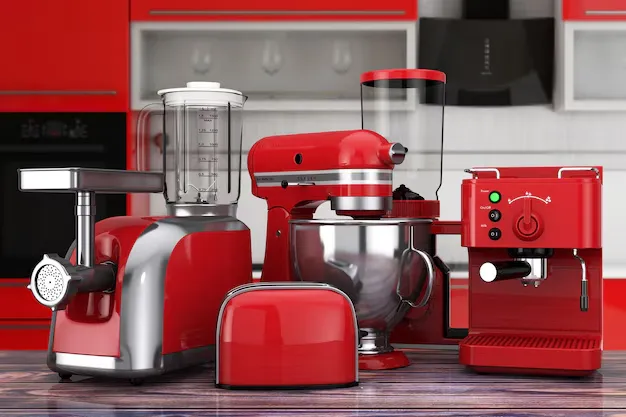Kitchen gadgets these days are getting wild—some are so smart they’re outsmarting the folks using them. From ovens that talk to your phone to blenders that pick recipes, it’s like we’re letting machines take the wheel while we just poke buttons. Sure, it saves time, but it’s also turning us into gadget-dependent slackers who don’t even know how to chop an onion without an app telling us how. Tucked in our homes, these tools are packing tech that’s ahead of the curve, and it’s making us wonder who’s running the kitchen. Let’s break down why these gadgets are getting brainier, how they’re changing our game, and what it means for us cooks, smart or not.

Gadgets with More Brains
These days, kitchen gadgets come loaded with tech that’d make your grandma’s hand mixer jealous. Take the Instant Pot Duo Crisp—it’s got a touchscreen, Wi-Fi, and sensors that adjust pressure and heat on their own. Or the Thermomix TM6, a blender that chops, cooks, and even weighs ingredients while following recipes from its built-in screen. Even simple toasters like the Revolution InstaGLO have apps to pick your toast level. These machines use AI-like smarts to figure out cooking times and temps, leaving us to just watch. It’s cool until you realize the gadget knows more about your roast than you do.
Hands-Off Cooking Takeover
With smart gadgets, you barely lift a finger. The June Oven uses cameras and AI to spot your food—chicken, pizza, whatever—and cooks it without you setting a timer. Samsung’s Smart Fridge scans groceries and suggests meals, while the Tovala Smart Oven steams and bakes with a barcode scan. It’s like having a chef who doesn’t talk back, but it means you’re not learning the feel of a perfect sear or the smell of done bread. After a month of this, you might forget how to eyeball a potato bake, letting the machine call the shots.
Learning Curves That Stump Us
These gadgets sound easy, but the setup can trip you up. The Anova Precision Oven needs an app to unlock its full steam-cooking magic, and good luck figuring it out without reading a manual thicker than a cookbook. The Ninja Foodi Smart XL Grill’s app syncs with probes, but if you miss an update, it’s just a fancy brick. People joke about spending more time troubleshooting than cooking—my buddy Dave spent an hour syncing his smart kettle before giving up. That brainy tech can leave you scratching your head instead of stirring the pot.
Over-Reliance on Tech
We’re leaning on these gadgets way too much. Got a smart coffee maker like the Café Smart Coffee Maker? It grinds, brews, and schedules itself, so you don’t even need to know how coffee works. Same with the Breville Smart Air Fryer—toss in fries, hit a button, and done. But when the Wi-Fi drops or the app crashes, you’re stuck. I’ve seen folks panic when their smart microwave conks out mid-meal, like they’ve lost a limb. It’s handy until you realize you’ve forgotten the basics—like boiling water without a smart pot telling you how.
Cost vs. Know-How Trade-Off
Smart gadgets hit your wallet hard. The Thermomix TM6 runs around $2,000, and the June Oven isn’t cheap at $600. You’re paying for brains, not just blades, but it’s a trade-off—spend big to skip learning, or save cash and figure it out yourself. My cousin dropped $300 on a smart blender, then realized he could’ve bought a $50 one and learned to whip cream by hand. The tech’s slick, but it’s robbing us of kitchen smarts, leaving us dependent on pricey toys that might break.
Privacy Peeks in the Kitchen
These gadgets are watching you. The Samsung Smart Fridge logs what you eat, and the Amazon Echo Show in the kitchen listens to your orders—and maybe your gossip. The June Oven’s camera tracks your cooking, sending data to the cloud. It’s handy for recipe tips, but it feels like Big Brother’s in your spice rack. I heard a guy complain that his smart oven suggested ads based on his burnt toast—creepy! That smart edge comes with a price: your kitchen’s secrets might not stay yours.
Fun Factor vs. Real Skills
Smart gadgets are a blast at first. The SodaStream Art with its app lets you mix custom sodas, and the Philips Smart Pasta Maker beeps when your noodles are done—pure fun. Kids love watching the Cuisinart Smart Stick blender blend with lights, turning cooking into a game. But that fun can ditch real skills. You might nail a recipe with an app, but can you knead dough or judge a sauce’s thickness? After a few months, you’re a gadget pro, not a cook, missing out on the hands-on know-how.
Breaking Down When We Need Them
When these smart tools fail, you’re in trouble. The Breville Smart Grill’s app crashed mid-cook, leaving my neighbor with raw burgers. A smart rice cooker’s sensor died, and no one knew how to fix the timing manually. Parts like the Anova Sous Vide’s circulator can burn out, and without the app, you’re lost. They’re built to be smart, not tough—my old hand mixer still works after 20 years. Relying on them means you’re sunk when the tech flops, and that’s a risky bet.
Keeping Up with Updates
Smart gadgets need constant tinkering. The Instant Pot’s app pushes updates for new recipes, but miss one, and it might not cook right. The Philips Smart Air Fryer needs firmware fixes to handle new foods, and my aunt spent an afternoon updating her smart toaster just to keep it toasting. It’s like owning a pet—feed it updates or it sulks. That brainy tech demands you stay on top, or you’re back to square one, which can feel like more work than cooking old-school.
Balancing Smart Tools and Old-School Ways
The trick is mixing smart gadgets with your own skills. Use a smart oven like the June for big roasts, but learn to chop onions by hand—takes 5 minutes with a sharp knife. Keep a manual kettle alongside your smart coffee maker for backup. My buddy swears by his grandma’s cast-iron skillet even with a fancy air fryer. It’s about leaning on tech for speed but keeping the basics alive—knowing how to boil, fry, or bake without an app. After a year, you’ll have the best of both, not just a gadget slave.




